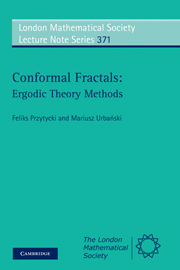Book contents
- Frontmatter
- Contents
- Introduction
- 1 Basic examples and definitions
- 2 Measure-preserving endomorphisms
- 3 Ergodic theory on compact metric spaces
- 4 Distance-expanding maps
- 5 Thermodynamical formalism
- 6 Expanding repellers in manifolds and in the Riemann sphere: preliminaries
- 7 Cantor rep ellers in the line; Sullivan's scaling function; application in Feigenbaum universality
- 8 Fractal dimensions
- 9 Conformal expanding repellers
- 10 Sullivan's classification of conformal expanding repellers
- 11 Holomorphic maps with invariant probability measures of positive Lyapunov exponent
- 12 Conformal measures
- References
- Index
6 - Expanding repellers in manifolds and in the Riemann sphere: preliminaries
Published online by Cambridge University Press: 05 April 2013
- Frontmatter
- Contents
- Introduction
- 1 Basic examples and definitions
- 2 Measure-preserving endomorphisms
- 3 Ergodic theory on compact metric spaces
- 4 Distance-expanding maps
- 5 Thermodynamical formalism
- 6 Expanding repellers in manifolds and in the Riemann sphere: preliminaries
- 7 Cantor rep ellers in the line; Sullivan's scaling function; application in Feigenbaum universality
- 8 Fractal dimensions
- 9 Conformal expanding repellers
- 10 Sullivan's classification of conformal expanding repellers
- 11 Holomorphic maps with invariant probability measures of positive Lyapunov exponent
- 12 Conformal measures
- References
- Index
Summary
In this chapter we shall consider a compact metric space X with an open, distance-expanding map T on it, embedded isometrically into a smooth Riemannian manifold M. We shall assume that T extends to a neighbourhood U of X to a mapping f of class C1+ε for some 0 < ε ≤ 1 or smoother, including real-analytic. C1+ε and more general Cr+ε for r = 1, 2, … means that the r-th derivative is Hölder continuous with the exponent ε for ε < 1 and Lipschitz continuous for ε = 1. We shall also assume that there exists a constant λ > 1 such that for every x ϵ U and for every non-zero vector v tangent to M at x, ∥Df(v)∥ > λ∥v∥ holds, where ∥·∥ is the norm induced by the Riemannian metric. The pair (X, f) will be called an expanding repeller and f an expanding map. If f is of some class A, e.g. Cα or analytic, we shall say that the expanding repeller is of that class, or that this is an A-expanding repeller. In particular, if f is conformal we call (X, f) a conformal expanding repeller, abbreviated to CER. Finally, if we skip the assumption that T = f∣x is open on X, we shall call (X, f) an expanding set. Sometimes, to distinguish the domain of f, we shall write (X, f, U).
In Sections 6.2 and 6.3 we provide some introduction to conformal expanding repellers, studying the transfer operator, postponing the main study to Chapters 9 and 10, where we shall use tools of geometric measure theory.
- Type
- Chapter
- Information
- Conformal FractalsErgodic Theory Methods, pp. 166 - 184Publisher: Cambridge University PressPrint publication year: 2010



